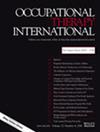韩文《婴幼儿流口水量表》的编制
IF 0.9
4区 医学
Q3 REHABILITATION
引用次数: 0
摘要
客观的本研究旨在将Drooling婴幼儿和学龄前儿童量表(DRIPS)翻译并跨文化地适应韩国文化背景,并检验韩文版本(即K-DRIPS)的内容有效性和可靠性。方法。DRIPS的迭代前向后向翻译序列由20名具有10多年经验的韩国卫生专业专家(即职业治疗师和教授)执行。研究对象为77名表现出流口水症状的脑瘫(CP)儿童,年龄为2-7岁。他们是从韩国两家儿童康复医院招募来的,完成了K-DRIPS。检验K-DRIPS项目的内容有效性和内部一致性。后果对20个K-DRIPS项目的评估充分且跨文化地适应了韩国。所有项目均表现出良好的内容有效性(内容有效率范围4.00-4.95)和良好的内部一致性(Cronbachα=0.98)。结论研究结果表明,K-DRIPS成功地适应了韩国的文化背景,并表现出良好的心理测量特性。该仪器可用于韩国残疾儿童流口水的评估工具。本文章由计算机程序翻译,如有差异,请以英文原文为准。
Development of the Korean Version of the Drooling Infants and Preschoolers Scale
Objective. This study is aimed at translating and cross-culturally adapting the Drooling Infants and Preschoolers Scale (DRIPS) into Korean cultural context and examine the content validity and reliability of the Korean version, which is referred as K-DRIPS. Methods. An iterative forward-backward translation sequence of the DRIPS was performed by 20 Korean health professional experts (i.e., occupational therapists (OTs) and professors) with more than 10 years of experience. The study subjects were 77 children with cerebral palsy (CP) exhibiting drooling symptoms aged 2-7 years. They were recruited from two children’s rehabilitation hospitals in Korea and completed the K-DRIPS. The content validity and internal consistency of the K-DRIPS items were examined. Results. An assessment with 20 K-DRIPS items was adequately and cross-culturally adapted into Korea. All the items exhibited good content validity (content validity ratio range 4.00-4.95) and good internal consistency (Cronbach’s
α
=
0.98
). Conclusion. The study findings indicated that the K-DRIPS was successfully adapted to the Korean cultural context and demonstrated good psychometric properties. This instrument could be used for drooling assessment tool in Korean children with disabilities.
求助全文
通过发布文献求助,成功后即可免费获取论文全文。
去求助
来源期刊

Occupational Therapy International
REHABILITATION-
CiteScore
2.50
自引率
6.70%
发文量
121
审稿时长
>12 weeks
期刊介绍:
Occupational Therapy International is a peer-reviewed journal, publishing manuscripts that reflect the practice of occupational therapy throughout the world. Research studies or original concept papers are considered for publication. Priority for publication will be given to research studies that provide recommendations for evidence-based practice and demonstrate the effectiveness of a specific treatment method. Single subject case studies evaluating treatment effectiveness are also encouraged. Other topics that are appropriate for the journal include reliability and validity of clinical instruments, assistive technology, community rehabilitation, cultural comparisons, health promotion and wellness.
 求助内容:
求助内容: 应助结果提醒方式:
应助结果提醒方式:


